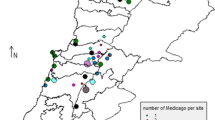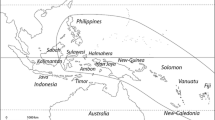Abstract
Chaya (Cnidoscolus aconitifolius) (Mill.) I.M. Johnst is a neglected and underutilized crop, cultivated clonally by the Maya from pre-Hispanic times to the present in their home gardens for their own consumption. Like other crops in the early stages of domestication, cultivated chaya co-occurs with its wild relatives, however, the degree of domestication of chaya is unclear. Wild and cultivated chaya exhibit some morphological differences, however, no study has assessed quantitatively the degree of divergence between these varieties. The main objective of this study was to assess the domestication degree of chaya, by measuring morphological divergence in vegetative traits (leaf number, area, toughness, trichome number, as well as plant size, number of branches and trunk width) in wild and cultivated plants. Our results show that cultivated and wild plants had only a minor degree of overlap in the multivariate morphological space. The cultivated variety had more branches and leaves, and their leaves were softer and had fewer trichomes than the wild variety. This divergence is probably reinforced by the fact that desirable traits (number of branches and leaves) are negatively correlated with undesired traits (number of trichomes and toughness). Despite significant divergences between the two varieties, a few cultivated plants fell within phenotypic range of variation for wild plants, which could be due to recent artificial selection.


Similar content being viewed by others
References
Abdala-Roberts L, Parra-Tabla V (2005) Artificial defoliation induces trichome production in the tropical shrub Cnidoscolus aconitifolius (Euphorbiaceae). Biotropica 37:251–257
Aguilar-Luna JME, García-Villanueva E, Macario-Mendoza PA, Huerta-Lwanga E, de Alba-Becerra R (2012) Effect of the plantation density on the growth and productivity of Cnidoscolus chayamansa McVaugh (Euphorbiaceae). Trop Subtrop Agroecosyst 15:77–86
Aguirre-Dugua X, Eguiarte LE, González-Rodríguez A, Casas A (2012) Round and large: morphological and genetic consequences of artificial selection on the gourd tree Crescentia cujete by the Maya of the Yucatan Peninsula, Mexico. Ann Bot 109:1297–1306
Aye PA (2012) Effect of processing on the nutritive characteristics, anti-nutritional factors and functional properties of Cnidoscolus aconitifolius leaves. Am J Food Nutr 2:89–95
Breckon GJ (1975) Cnidoscolus, section Calyptosolen (Euphorbiaceae) in Mexico and Central America. Ph.D. Dissertation, University of California, Davis
Carbajal M (1998) Biología reproductiva y efectos de la herbivoría en la expresión sexual y el éxito reproductivo en la planta monoica Cnidoscolus aconitifolius Mill I.M. John (Euphorbiaceae). B.Sc. Thesis. Universidad Autónoma de Yucatán, Mérida
Casas A, Caballero J, Valiente-Banuet A, Soriano JA, Davila P (1999) Morphological variation and the process of domestication of Stenocereus stellatus (Cactaceae) in central Mexico. Am J Bot 86:522–533
Colunga-García Marín P, May-Pat F (1997) Morphological variation of henequen (Agave fourcroydes, Agavaceae) germplasm and its wild ancestor (A. angustifolia) under uniform growth conditions: diversity and domestication. Am J Bot 84:1449–1465
Core Team R (2018) R: a language and environment for statistical computing. R Foundation for Statistical Computing, Vienna
Cruz M, Casas A (2002) Morphological variation and reproductive biology of Polaskia chende (Cactaceae) under domestication in Central Mexico. J Arid Environ 51:561–576
De Vries IM (1997) Origin and domestication of Latuca sativa L. Genet Resour Crop Evol 44:165–174
Dzul-Tejero F, Coello-Coello J, Martínez-Castillo J (2014) Wild to crop introgression and genetic diversity in lima bean (Phaseolus lunatus L.) in traditional Mayan milpas from Mexico. Conserv Genet 15:1315–1328
Ellstrand NC, Prentice HC, Hancock JF (1999) Gene flow and introgression from domesticated plant into their wild relatives. Annu Rev Ecol Syst 30:539–563
FAO (2009) International treaty on plant genetic resources for food and agriculture. FAO, Rome
Fordyce JA, Agrawal AA (2002) The role of plant trichomes and caterpillar group size on growth and defense of the pipevine swallowtail Battus philenor. J Anim Ecol 70:997–1005
Galluzzi G, López-Noriega I (2014) Conservation and use of genetic resources of underutilized crops in the Americas: a continental analysis. Sustainability 6:980–1017
Galluzzi G, Eyzaguirre P, Ngeri V (2010) Home gardens: a neglected hotspot of agrobiodiversity and cultural diversity. Biodivers Conserv 19:3635–3654
Hammer K (1984) Das domestikationssyndrom. Kulturpflanze 32:11–14
Harlan JR (1975) Crops and man. American Society of Agronomy, Madison
Howard JJ (1988) Leaf cutting and diet selection: relative influence of leaf chemistry and physical features. Ecology 69:250–260
Ladizinsky G (1998) Plant evolution under domestication. Springer, Devon
McKey D, Elias M, Pujos B, Duputié A (2010) The evolutionary ecology of clonally propagated domesticated plants. New Phytol 186:318–332
Meyer RS, DuVal AE, Jensen HR (2012) Patterns and process in crop domestication: a historical review and quantitative analysis of 203 global food crops. New Phytol 196:29–48
Milla R, Osborne CP, Turcotte MM, Violle C (2015) Plant domestication through an ecological lens. Trends Ecol Evol 30:463–469
Miller AJ, Gross BL (2011) From forest to field: perennial fruit crop domestication. Am J Bot 98:1389–1414
Parker IM, López I, Petersen JJ, Anaya N, Cubilla-Rios L, Potter D (2010) Domestication syndrome in caimito (Chrisophyllum caimito): fruit and seed characteristics. Econ Bot 64:161–175
Parra-Tabla V, Rico-Gray V, Carbajal M (2004) Effect of defoliation on leaf growth, sexual expression and reproductive success in Cnidoscolus aconitifolius (Euphorbiaceae). Plant Ecol 173:153–160
Ross-Ibarra J (2003) Origen y domesticación de la chaya (Cnidoscolus aconitifolius Mill I.M., M. Johnst): La espinaca Maya. Mex Stud 19:287–302
Ross-Ibarra J, Molina-Cruz A (2002) The ethnobotany of chaya (Cnidoscolus aconitifolius ssp. aconitifolius Breckon): a nutritious Maya vegetable. Econ Bot 56:350–365
Santos del Blanco L, Alía R, González-Martínez SC, Sampedro S, Lario F, Climen J (2015) Correlated genetic effects on reproduction define a domestication syndrome in a forest tree. Evol Appl 8:403–410
Standley PC, Steyermark JA (1949) Flora of Guatemala. Vol. 24 Part. VI. Chicago Natural History Museum, Chicago
Thul TS, Lal KR, Shasany KA, Dorokar PM, Gupta KA, Gupta MM, Verma KR, Khanuja SPS (2009) Estimation of phenotypic divergence in a collection of Capsicum species for yield-related traits. Euphytica 168:189–196
Victor M, Abbey PA, Yohaya J, Zakka J, Yatai B, Oladeji M (2016) An underexploited tropical plant with promising economic value and the window of opportunities for researches: Cnidoscolus aconitifolius. Am J Food Sci Nutr Res 3:177–187
Williams JT, Haq N (2002) Global research on underutilized crops: an assessment of current activities and proposals of enhanced cooperation. ICUC, Southampton
Acknowledgements
The authors thank MT Castillo-Burgete for samples of cultivated plants from Campeche. We also thank all of the home garden owners for giving us permission to collect their cultivated chaya and for answering our questions. B Delfosse revised the English. This project was funded by the Consejo Nacional de Ciencia y Tecnología (Conacyt), project: CB-2015-255631-B (Funds to RB-B) and by Cinvestav (Funds to MAM-R).
Author information
Authors and Affiliations
Corresponding author
Ethics declarations
Conflict of interest
The authors declare that they have no conflict of interest. Informants gave verbal consent for the information they provided to be used for academic purposes.
Additional information
Publisher's Note
Springer Nature remains neutral with regard to jurisdictional claims in published maps and institutional affiliations.
Electronic supplementary material
Below is the link to the electronic supplementary material.
10722_2019_790_MOESM1_ESM.csv
Appendix S 1. Sites of origin of study plants. The state and coordinates are also shown. The number of individuals per variety (wild vs. cultivated) are shown in the last two columns (CSV 1 kb)
10722_2019_790_MOESM2_ESM.xlsx
Appendix S 2. Loading matrix for eight morphological vegetative variables of Cnidoscolus aconitifolius (Mill.) I.M. Johnst obtained from a principal component analysis. Explained variance (proportion) and cumulative explained variance per principal component (PC1-8) are also shown (XLSX 12 kb)
Rights and permissions
About this article
Cite this article
Munguía-Rosas, M.A., Jácome-Flores, M.E., Bello-Bedoy, R. et al. Morphological divergence between wild and cultivated chaya (Cnidoscolus aconitifolius) (Mill.) I.M. Johnst. Genet Resour Crop Evol 66, 1389–1398 (2019). https://doi.org/10.1007/s10722-019-00790-w
Received:
Accepted:
Published:
Issue Date:
DOI: https://doi.org/10.1007/s10722-019-00790-w




